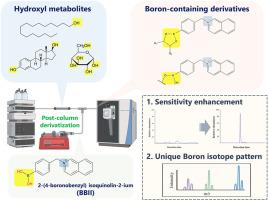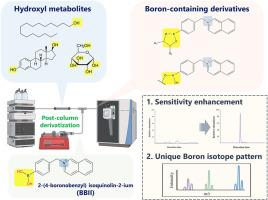A sensitive post-column derivatization approach for enhancing hydroxyl metabolites detection
IF 6
2区 化学
Q1 CHEMISTRY, ANALYTICAL
引用次数: 0
Abstract
Background
Chemical derivatization is a common technique in liquid chromatography-mass spectrometry (LC-MS) metabolomics used to improve the ionizability and chromatographic properties of metabolites in complex biological samples. This process facilitates better detection and separation of a wide array of compounds. The reagent 2-(4-boronobenzyl) isoquinolin-2-ium bromide (BBII), developed as a glucose labeling reagent for matrix-assisted laser desorption/ionization MS, enhances ionization for glucose and other hydroxyl metabolites. Its quaternary ammonium group increases ionization efficiency, and its rapid reaction time simplifies pretreatment procedures.
Results
We developed a novel post-column derivatization (PCD) method using BBII to boost the detection sensitivity of hydroxyl metabolites in LC-MS. By optimizing this BBII PCD approach with 14 hydroxyl-containing compounds, we were able to detect previously undetectable metabolites such as glucose, ribose, and long-chain alcohols. Sensitivity enhancements for these metabolites ranged from 1.1 to 42.9-fold. Applying this method to metabolic profiling of hydroxyl metabolites in the DBTRG-05MG glioblastoma cell line, with and without treatment with the new drug MFB [1-(4-chlorobenzyl)-2-(5-methyl-2-furfurylideneamino)benzimidazole], revealed several hydroxyl metabolites with significantly reduced levels post-treatment.
Significance and novelty
This study presents a new BBII PCD method that substantially improves the detection sensitivity of hydroxyl metabolites in LC-MS. This innovative approach is highly valuable for untargeted metabolomics studies in biological and clinical research, offering a robust tool for identifying metabolite changes and advancing our understanding of metabolic processes in disease and therapeutic contexts.


一种提高羟基代谢物检测灵敏度的柱后衍生化方法
化学衍生化是液相色谱-质谱(LC-MS)代谢组学中的一种常用技术,用于改善复杂生物样品中代谢物的电离性和色谱特性。这一过程有助于更好地检测和分离各种化合物。2-(4-硼苯基)异喹啉-2-溴化ium (BBII)试剂是一种用于基质辅助激光解吸/电离质谱的葡萄糖标记试剂,可增强葡萄糖和其他羟基代谢物的电离。它的季铵盐基团提高了电离效率,反应时间短,简化了预处理程序。结果建立了一种新的柱后衍生化(PCD)方法,提高了LC-MS中羟基代谢物的检测灵敏度。通过用14种含羟基化合物优化这种BBII PCD方法,我们能够检测到以前无法检测到的代谢物,如葡萄糖、核糖和长链醇。这些代谢物的敏感性提高了1.1到42.9倍。将该方法应用于DBTRG-05MG胶质母细胞瘤细胞系中羟基代谢物的代谢谱分析,在使用和未使用新药MFB[1-(4-氯苯基)-2-(5-甲基-2-呋喃基氨基)苯并咪唑]治疗后,发现几种羟基代谢物的水平显着降低。意义与创新本研究提出了一种新的BBII PCD方法,大大提高了LC-MS中羟基代谢物的检测灵敏度。这种创新的方法对于生物学和临床研究中的非靶向代谢组学研究非常有价值,为识别代谢物变化提供了一个强大的工具,并促进了我们对疾病和治疗背景下代谢过程的理解。
本文章由计算机程序翻译,如有差异,请以英文原文为准。
求助全文
约1分钟内获得全文
求助全文
来源期刊

Analytica Chimica Acta
化学-分析化学
CiteScore
10.40
自引率
6.50%
发文量
1081
审稿时长
38 days
期刊介绍:
Analytica Chimica Acta has an open access mirror journal Analytica Chimica Acta: X, sharing the same aims and scope, editorial team, submission system and rigorous peer review.
Analytica Chimica Acta provides a forum for the rapid publication of original research, and critical, comprehensive reviews dealing with all aspects of fundamental and applied modern analytical chemistry. The journal welcomes the submission of research papers which report studies concerning the development of new and significant analytical methodologies. In determining the suitability of submitted articles for publication, particular scrutiny will be placed on the degree of novelty and impact of the research and the extent to which it adds to the existing body of knowledge in analytical chemistry.
 求助内容:
求助内容: 应助结果提醒方式:
应助结果提醒方式:


